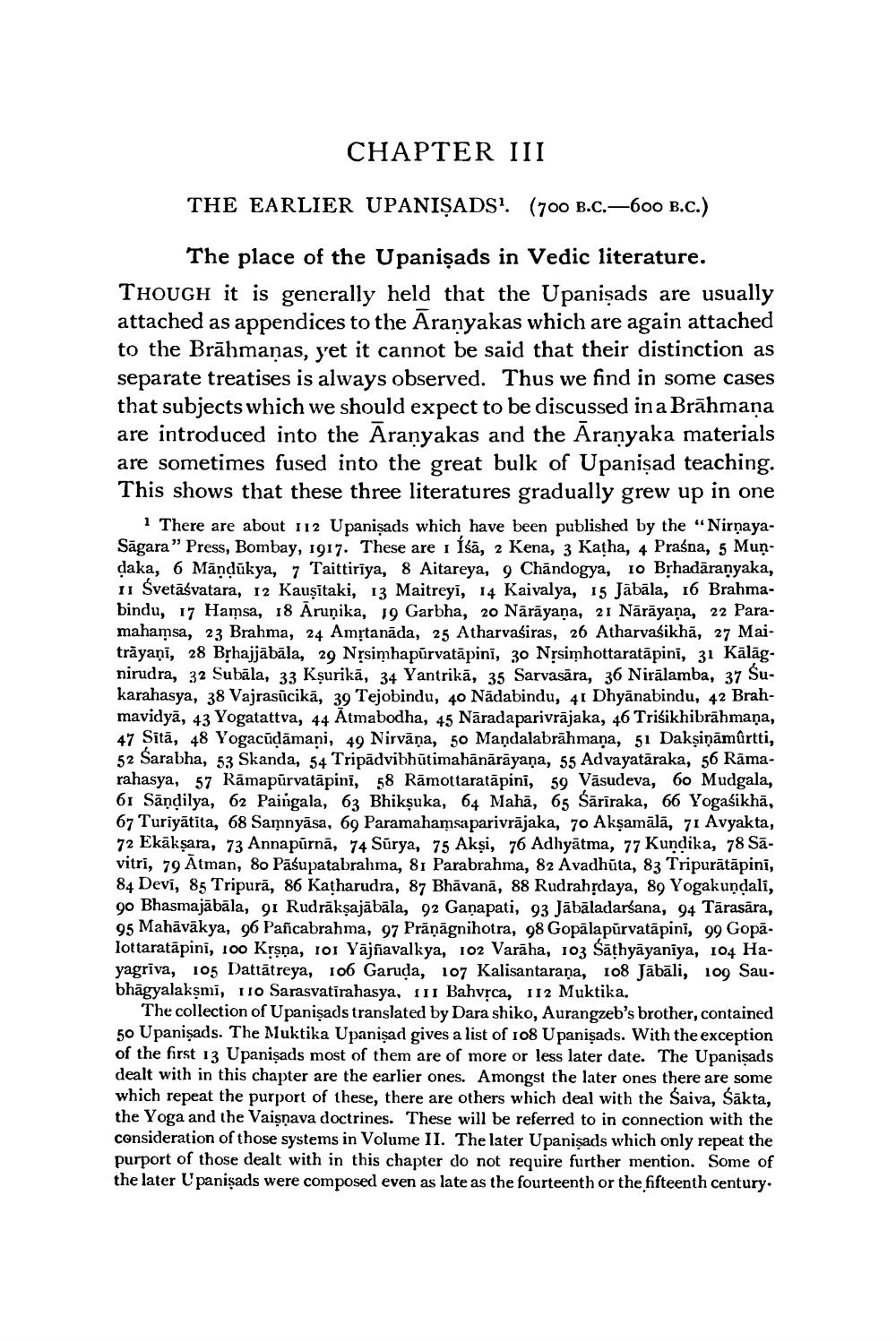________________
CHAPTER III
THE EARLIER UPANIŞADS! (700 B.C.—600 B.C.)
The place of the Upanişads in Vedic literature. Though it is generally held that the Upanişads are usually attached as appendices to the Aranyakas which are again attached to the Brähmanas, yet it cannot be said that their distinction as separate treatises is always observed. Thus we find in some cases that subjects which we should expect to be discussed in a Brāhmana are introduced into the Aranyakas and the Aranyaka materials are sometimes fused into the great bulk of Upanişad teaching. This shows that these three literatures gradually grew up in one
There are about 112 Upanişads which have been published by the "NirnayaSāgara” Press, Bombay, 1917. These are 1 Íšā, 2 Kena, 3 Katha, 4 Praśna, 5 Mun. daka, 6 Māņdūkya, 7 Taittirīya, 8 Aitareya, 9 Chāndogya, 10 Bịhadāranyaka, I Svetāśvatara, 12 Kausitaki, 13 Maitreyi, 14 Kaivalya, 15 Jābāla, 16 Brahmabindu, 17 Hamsa, 18 Āruņika, 19 Garbha, 20 Nārāyana, 21 Nārāyana, 22 Paramahamsa, 23 Brahma, 24 Amịtanāda, 25 Atharvaśiras, 26 Atharvaśikhā, 27 Maitrāyaṇī, 28 Bịhajjābāla, 29 Nțsimhapūrvatāpini, 30 Nysimhottaratāpini, 31 Kālāgnirudra, 32 Subāla, 33 Kșurikā, 34 Yantrikā, 35 Sarvasāra, 36 Nirālamba, 37 Sukarahasya, 38 Vajrasūcikā, 39 Tejobindu, 40 Nădabindu, 41 Dhyānabindu, 42 Brahmavidyā, 43 Yogatattva, 44 Atmabodha, 45 Nārada parivrājaka, 46 Trisikhibrāhmaṇa, 47 Sitā, 48 Yogacūdāmani, 49 Nirvāṇa, 50 Maņdalabrāhmaṇa, 51 Dakşiņāmûrtti, 52 Sarabha, 53 Skanda, 54 Tripādvibhūtimahānārāyaṇa, 55 Advayatāraka, 56 Rāmarahasya, 57 Rāmapūrvatāpini, 58 Rāmottaratāpini, 59 Vasudeva, 60 Mudgala, 61 Sandilya, 62 Paingala, 63 Bhikşuka, 64 Mahā, 65 Śārīraka, 66 Yogaśikhā, 67 Turiyātita, 68 Samnyāsa, 69 Paramahamsaparivrājaka, 70 Akşamālā, 71 Avyakta, 72 Ekākṣara, 73 Annapurnā, 74 Surya, 75 Akşi, 76 Adhyātma, 77 Kundika, 78 Sāvitri, 79 Ātman, 80 Pāśupatabrahma, 81 Parabrahma, 82 Avadhūta, 83 Tripurātāpini, 84 Devi, 85 Tripurã, 86 Katharuda, 87 Bhāvana, 88 Rudrahrdaya, 89 Yogakundali, 90 Bhasmajābāla, gi Rudrākṣajābāla, 92 Ganapati, 93 Jābāladarśana, 94 Tārasāra, 95 Mahāvākya, 96 Pancabrahma, 97 Prāṇāgnihotra, 98 Gopālapūrvatäpini, 99 Gopā. lottaratāpini, 100 Krşņa, roi Yājsavalkya, 102 Varāha, 103 Sāthyāyaniya, 104 Hayagriva, 105 Dattātreya, 106 Garuda, 107 Kalisantaraṇa, 108 Jābāli, 109 Saubhāgyalaksmi, no Sarasvatirahasya, iu Bahvrca, I12 Muktika.
The collection of Upanişads translated by Dara shiko, Aurangzeb's brother, contained 50 Upanişads. The Muktika Upanişad gives a list of 108 Upanişads. With the exception of the first 13 Upanişads most of them are of more or less later date. The Upanisads dealt with in this chapter are the earlier ones. Amongst the later ones there are some which repeat the purport of these, there are others which deal with the Saiva, Sākta, the Yoga and the Vaisnava doctrines. These will be referred to in connection with the consideration of those systems in Volume II. The later Upanisads which only repeat the purport of those dealt with in this chapter do not require further mention. Some of the later Upanişads were composed even as late as the fourteenth or the fifteenth century.
man, 80 Pasupai, 74 Sūrya, ansaparivrăjaka, 5 Säri




